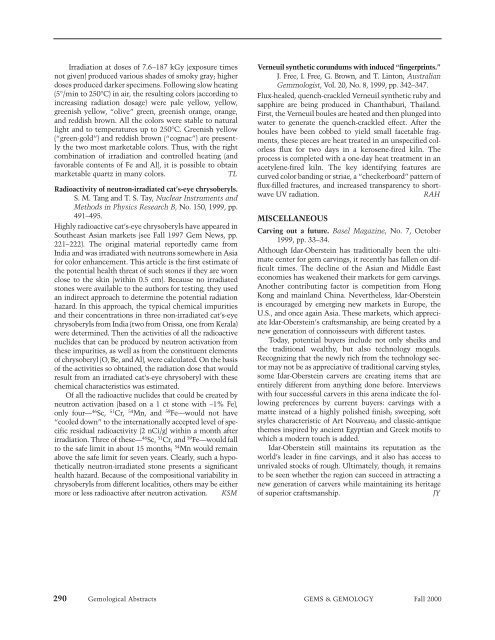Fall 2000 Gems & Gemology - Gemfrance
Fall 2000 Gems & Gemology - Gemfrance
Fall 2000 Gems & Gemology - Gemfrance
Create successful ePaper yourself
Turn your PDF publications into a flip-book with our unique Google optimized e-Paper software.
Irradiation at doses of 7.6–187 kGy (exposure times<br />
not given) produced various shades of smoky gray; higher<br />
doses produced darker specimens. Following slow heating<br />
(5°/min to 250°C) in air, the resulting colors (according to<br />
increasing radiation dosage) were pale yellow, yellow,<br />
greenish yellow, “olive” green, greenish orange, orange,<br />
and reddish brown. All the colors were stable to natural<br />
light and to temperatures up to 250°C. Greenish yellow<br />
(“green-gold”) and reddish brown (“cognac”) are presently<br />
the two most marketable colors. Thus, with the right<br />
combination of irradiation and controlled heating (and<br />
favorable contents of Fe and Al), it is possible to obtain<br />
marketable quartz in many colors. TL<br />
Radioactivity of neutron-irradiated cat’s-eye chrysoberyls.<br />
S. M. Tang and T. S. Tay, Nuclear Instruments and<br />
Methods in Physics Research B, No. 150, 1999, pp.<br />
491–495.<br />
Highly radioactive cat’s-eye chrysoberyls have appeared in<br />
Southeast Asian markets (see <strong>Fall</strong> 1997 Gem News, pp.<br />
221–222). The original material reportedly came from<br />
India and was irradiated with neutrons somewhere in Asia<br />
for color enhancement. This article is the first estimate of<br />
the potential health threat of such stones if they are worn<br />
close to the skin (within 0.5 cm). Because no irradiated<br />
stones were available to the authors for testing, they used<br />
an indirect approach to determine the potential radiation<br />
hazard. In this approach, the typical chemical impurities<br />
and their concentrations in three non-irradiated cat’s-eye<br />
chrysoberyls from India (two from Orissa, one from Kerala)<br />
were determined. Then the activities of all the radioactive<br />
nuclides that can be produced by neutron activation from<br />
these impurities, as well as from the constituent elements<br />
of chrysoberyl (O, Be, and Al), were calculated. On the basis<br />
of the activities so obtained, the radiation dose that would<br />
result from an irradiated cat’s-eye chrysoberyl with these<br />
chemical characteristics was estimated.<br />
Of all the radioactive nuclides that could be created by<br />
neutron activation (based on a 1 ct stone with ~1% Fe),<br />
only four— 46 Sc, 51 Cr, 54 Mn, and 59 Fe—would not have<br />
“cooled down” to the internationally accepted level of specific<br />
residual radioactivity (2 nCi/g) within a month after<br />
irradiation. Three of these— 46 Sc, 51 Cr, and 59 Fe—would fall<br />
to the safe limit in about 15 months; 54 Mn would remain<br />
above the safe limit for seven years. Clearly, such a hypothetically<br />
neutron-irradiated stone presents a significant<br />
health hazard. Because of the compositional variability in<br />
chrysoberyls from different localities, others may be either<br />
more or less radioactive after neutron activation. KSM<br />
Verneuil synthetic corundums with induced “fingerprints.”<br />
J. Free, I. Free, G. Brown, and T. Linton, Australian<br />
Gemmologist, Vol. 20, No. 8, 1999, pp. 342–347.<br />
Flux-healed, quench-crackled Verneuil synthetic ruby and<br />
sapphire are being produced in Chanthaburi, Thailand.<br />
First, the Verneuil boules are heated and then plunged into<br />
water to generate the quench-crackled effect. After the<br />
boules have been cobbed to yield small facetable fragments,<br />
these pieces are heat treated in an unspecified colorless<br />
flux for two days in a kerosene-fired kiln. The<br />
process is completed with a one-day heat treatment in an<br />
acetylene-fired kiln. The key identifying features are<br />
curved color banding or striae, a “checkerboard” pattern of<br />
flux-filled fractures, and increased transparency to shortwave<br />
UV radiation. RAH<br />
MISCELLANEOUS<br />
Carving out a future. Basel Magazine, No. 7, October<br />
1999, pp. 33–34.<br />
Although Idar-Oberstein has traditionally been the ultimate<br />
center for gem carvings, it recently has fallen on difficult<br />
times. The decline of the Asian and Middle East<br />
economies has weakened their markets for gem carvings.<br />
Another contributing factor is competition from Hong<br />
Kong and mainland China. Nevertheless, Idar-Oberstein<br />
is encouraged by emerging new markets in Europe, the<br />
U.S., and once again Asia. These markets, which appreciate<br />
Idar-Oberstein’s craftsmanship, are being created by a<br />
new generation of connoisseurs with different tastes.<br />
Today, potential buyers include not only sheiks and<br />
the traditional wealthy, but also technology moguls.<br />
Recognizing that the newly rich from the technology sector<br />
may not be as appreciative of traditional carving styles,<br />
some Idar-Oberstein carvers are creating items that are<br />
entirely different from anything done before. Interviews<br />
with four successful carvers in this arena indicate the following<br />
preferences by current buyers: carvings with a<br />
matte instead of a highly polished finish; sweeping, soft<br />
styles characteristic of Art Nouveau; and classic-antique<br />
themes inspired by ancient Egyptian and Greek motifs to<br />
which a modern touch is added.<br />
Idar-Oberstein still maintains its reputation as the<br />
world’s leader in fine carvings, and it also has access to<br />
unrivaled stocks of rough. Ultimately, though, it remains<br />
to be seen whether the region can succeed in attracting a<br />
new generation of carvers while maintaining its heritage<br />
of superior craftsmanship. JY<br />
290 Gemological Abstracts GEMS & GEMOLOGY <strong>Fall</strong> <strong>2000</strong>


